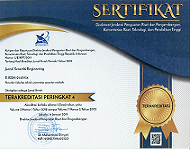Pengaruh Jarak Anoda Seng Dengan Tanaman Equisetum hyemale Dalam Sistem Constructed Wetland-Microbial Fuel Cell (CW-MFC) Terhadap Penurunan Polutan Air Limbah IPLT
Keywords:
IPLT, Constructed Wetland, Microbial Fuel Cell, COD, Total Nitrogen, Equisetum hyemale, bioelektrikAbstract
Fecal Sludge Treatment Plant (IPLT) effluent contains high concentrations of organic pollutants and nutrients, requiring further treatment before discharge into the environment. This study aimed to evaluate the performance of a combined Constructed Wetland–Microbial Fuel Cell (CW-MFC) system in reducing Chemical Oxygen Demand (COD) and Total Nitrogen (TN) levels, while simultaneously generating electricity from IPLT wastewater in Surabaya, Indonesia. A laboratory-scale CW-MFC reactor was designed with horizontal subsurface flow, using Malang sand as the substrate and Equisetum hyemale as the phytoremediation agent. Experimental variables included anode type (zinc and carbon), electrode spacing (20 cm and 30 cm), and contact time (0, 3, 9, 12, and 15 days). Parameter analyses followed Indonesian National Standard (SNI) methods, and data processing employed Two-Way ANOVA statistical analysis. Results indicated that the highest COD removal efficiency reached 95% and TN removal reached 98% on day 12 with an electrode spacing of 30 cm. The system also achieved a maximum power output of 495.6 mW, sufficient to operate small-scale electronic devices. Pollutant removal mechanisms involved the synergistic action of electrogenic microbes at the anode, oxygen release from plant roots facilitating oxidation, and reduction reactions at the cathode.
References
[1] N. L. Angrianto, J. Manusawai, and A. S. Sinery, “Analisis Kualitas Air Lindi dan Permukaan pada areal TPA Sowi Gunung dan Sekitarnya di Kabupaten Manokwari Papua Barat,” Cassowary, vol. 4, no. 2, pp. 221–233, 2021, doi: 10.30862/casssowary.cs.v4.i2.79.
[2] Republik Indonesia, “Permen LHK No. 68 Tahun 2016,” Tentang Baku Mutu Air Limbah Domest., pp. 1–13, 2016, [Online]. Available: https://p3ekalimantan.menlhk.go.id/2016/09/30/permen-lhk-nomor-p-68-menlhk-setjen-kum-1-8-2016/
[3] T. Yamane, N. Yoshida, and M. Sugioka, “Estimation of total energy requirement for sewage treatment by a microbial fuel cell with a one-meter air-cathode assuming Michaelis-Menten COD degradation,” RSC Adv., vol. 11, no. 33, pp. 20036–20045, 2021, doi: 10.1039/d1ra03061b.
[4] S. Das, S.-H. Lee, P. Kumar, K.-H. Kim, S. S. Lee, and S. S. Bhattacharya, “Solid waste management: Scope and the challenge of sustainability,” J. Clean. Prod., vol. 228, pp. 658–678, 2019, doi: https://doi.org/10.1016/j.jclepro.2019.04.323.
[5] S. Gadkari, J. M. Fontmorin, E. Yu, and J. Sadhukhan, “Influence of temperature and other system parameters on microbial fuel cell performance: Numerical and experimental investigation,” Chem. Eng. J., vol. 388, no. July 2019, p. 124176, 2020, doi: 10.1016/j.cej.2020.124176.
[6] Alviomora, Cici. Ftoremediasi Tanaman Daun Kiambang Dan Kayu Apu Terhadap Penurunan Kadar COD Limbah Cair Batik Home Industri Batik. Diss. Universitas Muhammadiyah Semarang, 2018.
[7] Suharwati, Sri Ira, and Fadolul Ghafur. "Processing Leaf Waste Into Compost Using Rice Water And Em4 Fermentation Activators." Entita: Jurnal Pendidikan Ilmu Pengetahuan Sosial dan Ilmu-Ilmu Sosial (2025): 63-74.
[8] A. Hermayanti and I. Nugraha, “Potensi perolehan energi listrik dari limbah cair industri tahu dengan metode salt bridge microbial fuel cell (The potency of obtaining electrical energy from tofu industry liquid waste using salt bridge microbial fuel cell method),” J. Sains Dasar, vol. 3, no. 2, pp. 162–168, 2014.
[9] S. J. Zeiger and J. A. Hubbart, “Measuring and modeling event-based environmental flows: An assessment of HEC-RAS 2D rain-on-grid simulations,” J. Environ. Manage., vol. 285, no. January, p. 112125, 2021, doi: 10.1016/j.jenvman.2021.112125.
[10] K. Fent, G. Chew, J. Li, and E. Gomez, “Benzotriazole UV-stabilizers and benzotriazole: Antiandrogenic activity in vitro and activation of aryl hydrocarbon receptor pathway in zebrafish eleuthero-embryos,” Sci. Total Environ., vol. 482–483, no. 1, pp. 125–136, 2014, doi: 10.1016/j.scitotenv.2014.02.109.
[11] S. Kesarwani, D. Panwar, J. Mal, N. Pradhan, and R. Rani, “Constructed Wetland Coupled Microbial Fuel Cell: A Clean Technology for Sustainable Treatment of Wastewater and Bioelectricity Generation,” Fermentation, vol. 9, no. 1, 2023, doi: 10.3390/fermentation9010006.
[12] P. Ramesh et al., “Recent Trends in the Use of Electrode Materials for Microbial Fuel Cells Accentuating the Potential of Photosynthetic Cyanobacteria and Microalgae: A Review,” Processes, vol. 13, no. 5, 2025, doi: 10.3390/pr13051348.
[13] Q. Wu, J. Liu, Q. Li, W. Mo, R. Wan, and S. Peng, “Effect of Electrode Distances on Remediation of Eutrophic Water and Sediment by Sediment Microbial Fuel Cell Coupled Floating Beds,” Int. J. Environ. Res. Public Health, vol. 19, no. 16, 2022, doi: 10.3390/ijerph191610423.
[14] D. D. Leicester, J. M. Amezaga, A. Moore, and E. S. Heidrich, “Optimising the hydraulic retention time in a pilot-scale microbial electrolysis cell to achieve high volumetric treatment rates using concentrated domestic wastewater,” Molecules, vol. 25, no. 12, 2020, doi: 10.3390/molecules25122945.
[15] M. Golzarian, M. Ghiasvand, S. Shokri, M. Bahreini, and F. Kazemi, “Performance evaluation of a dual-chamber plant microbial fuel cell developed for electricity generation and wastewater treatment,” Int. J. Environ. Sci. Technol., vol. 21, no. 7, pp. 5947–5954, 2024, doi: 10.1007/s13762-023-05415-5.
Downloads
Published
Issue
Section
License
Copyright (c) 2025 Bellatrix Putri Arylis, Aussie Amalia (Author)

This work is licensed under a Creative Commons Attribution 4.0 International License.












